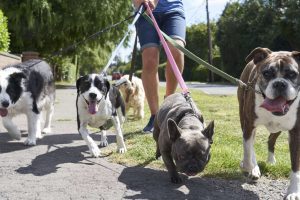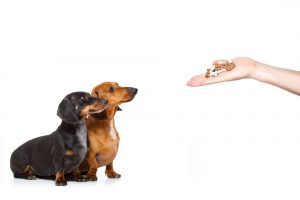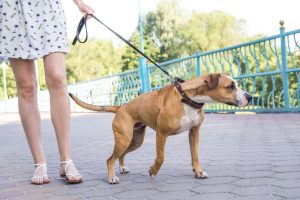![]()
HeelBoyHeel is reader supported. When you buy through any link on our site, we may earn an affiliate commission, but never at any extra cost to you.
One of the highlights of you and your dog’s day will be the walk. Bad weather will not dampen your dog’s enthusiasm to get out and about and once out, you will forget the weather and enjoy the exercise and companionship.
However, what will affect how much you enjoy the walk is how obedient your dog is on the leash. Good leash manners don’t usually happen by accident and so you will both have to work together to achieve this.
Understand Why Dogs Pull On The Leash

By understanding why it is natural for your dog or puppy to pull on the leash, you are more capable of correcting this and instil the behaviour you want. You may also find that you have (unwittingly) been encouraging your dog to pull.
When out for a walk on the leash, your dog will want to investigate many different smells, people and other dogs. In order to start the “investigation” as soon as possible, your dog is going to pull you towards the item of interest. If you are constantly playing Dr Watson to your dog’s Sherlock, he or she will assume that this is acceptable behaviour and it will be harder for you to reverse it. So, if you can identify with Dr Watson, the tips below will help.
Tips To Improve Walking Behaviour
1. Adjust Your Attitude
Now you are aware that your dog or puppy pulling you around the park is not a power struggle, just natural inquisitiveness and enthusiasm. So, instead of turning the daily walk into a contest to see who can pull the hardest, make yourself more interesting and better to be with than the peculiar smell, person or dog that he or she found so interesting before. With this new knowledge and attitude, you will be able to start training sessions to attain loose leash walking for both you and your dog!
Also, be prepared to commit time, patience and consistency in the training period – this will take time, especially if you have an older dog who has got into bad habits.
2. It’s All About Rewards

All successful relationships are based on a reciprocal give and take. This is exactly the same for you and your dog. By rewarding good behaviour, you are endorsing the behaviour you want from your dog.
A reward can be vocal praise, a stroke and a bit of fuss or, (probably top of your dog’s list!), a dog treat.
However, as well as a reward, your dog will expect your full attention when leash training, so, put the mobile phone back in your pocket! After all, what you are trying to achieve will take your dog’s full attention.
3. The “Follow The Leader” Game
Most of us have enjoyed playing “Follow The Leader” at some time in our life. The leader tries to make everyone follow by making the route interesting, so that they still want to follow. Therefore, this is the perfect game to incorporate into your leash training regime.
One of the easiest ways to make yourself an interesting “leader”, is to have a handful of tasty dog treats in your pocket. Use a vocal command to encourage your dog to follow you and reward your dog when he or she does so. Make sure to use the same command every time to avoid confusing your dog or puppy.
4. Practice On Daily Walks
Your dog needs regular walks on a leash for mental stimulation and socialisation. However, walking on a loose leash is not going to provide enough exercise for your dog, unless you plan on having very, very long walks or you have a very young or old hound who tires easily.
To make loose leash training easier, exercise your dog before the daily walk, off the leash. He or she will then have expended energy, investigated any smells of interest and will be more inclined to concentrate on the job in hand.
Plan the route for your walk. Choose a walk where you walk back the way you came, rather than a circular route. On the return journey, there will be less distractions for your dog, as he or she has seen it all before! This will help your dog or puppy concentrate on what you are trying to achieve.
Consistency is important with all types of dog training and especially so on the daily walk.
5. Reward Often

When you first get your puppy or dog, you have to start to build a relationship that will last a long time. Your new hound is suddenly in a strange environment with a person or family, usually previously unknown. Pretty scary when you put yourself in his or her paws! Until you have managed to build up a degree of trust and confidence between you and your dog, rewards are the way to go. As your dog gains confidence in you and his or her new surroundings, there will start to be a silent understanding between both of you.
Until that time, use a lot of fuss, attention and dog treats to encourage your dog to attain the behavior you want, especially in loose leash training. Reward all positive actions and make sure you don’t reward any unwanted behaviors. Don’t worry that special treats seem the only reason your dog responds to you, before long the wonderful treats can be reduced. With time, it will become learnt behavior for your dog.
6. Consider Additional Help

Loose leash walking is one of the most difficult challenges you will face as a pet parent. Most dog owners have felt a little more than envy on seeing a dog and owner walking side by side, as they charge past, pulled by an over enthusiastic hound.
If you have tried a training method or three, with no success, don’t beat yourself up. Every dog or puppy is different and will respond to different methods.
Now is the time to consider additional help. This can be from someone you know, who may be able to give advice. However, consider the help of a professional dog trainer. A dog training class may be just what your dog and you need. He or she will watch other dogs and learn what is expected and you will be able to discuss your problems with other pet owners – chances are, their dog problems will be bigger than yours! A positive experience for both of you.
Make Sure You Choose The Correct Equipment
1. The Collar

A traditional collar for your new dog or pup is essential. You can attach his or her details with regard to name, address and vaccination status to it. When choosing a collar, it is all down to comfort and size to suit your dog. A flat collar is best for comfort and you must be able to get two fingers between the collar and your dog’s neck when fastened. If you have a puppy, check regularly that the sizing is correct – that puppy is going to grow!
However, a collar is not really the best choice for attaching a leash to. Especially for a puppy or a dog with breathing difficulties, such as a Pug, The same applies for a dog that pulls a lot, it can result in your dog coughing and shortness of breath. You will have less control over your dog when she or he has the leash attached to the collar.
As well as traditional collars, there are a variety of collars called “training” collars. These include slip, choke and prong collars which tighten when your dog or pup pulls and also electronic collars. These rely on causing pain to your puppy to deter him or her from pulling. Although this will build some sort of relationship between you and your dog, this is not the sort of relationship you want to have with your new best friend. A relationship based on trust rather than fear.
2. The Harness
Harnesses are great for dogs! The harness reduces the pressure on your dog’s neck and transfers it to the chest area. Some people, of a certain age, may remember reigns! Your mother or grandmother would not have attached a leash to a collar around your neck, (hopefully!), the leash was attached to a chest harness.
As well as being a jolly sight more comfortable for your furry friend, a harness will also give you extra control. It does not stop your dog from pulling but you can train without inflicting pain. Choose a harness to fit your dog or puppy correctly. Many vet practices sell dog equipment and will be able to advise you on what is the right harness for your dog or pup, or try a reputable pet store.
3. The Leash

You are both going to be attached to this, so make sure that it is something comfortable for you to hold in your hand. It does not want to be so thin that it digs into your hand. Choose something appropriate for the size and pulling power of your dog or pup.
The leash does not want to be too long or too short. Too long and you have less control and too short you will also be investigating “interesting” smells”! So, choose a leash between six to ten feet as a rough guide.
Retractable leashes are really not appropriate when training your dog or pup not to pull.
How To Handle Lunging And Barking
Once again, if you know why your dog is lunging and barking, you are in a better position to help him or her. There are basically three reasons why you may find yourself with this problem. The two most common are leash related. For example, your dog wants the approaching dog or person to go away or your dog is keen to see the dog or person, and by being on a leash both are unable to achieve either of these. The third, which is rare, is that your dog really does not like other dogs and people.
The first thing to do is identify what triggers the reaction. When you have identified the cause you can help your friend by walking in places where the triggers are less likely. Look out for any potential problem so that you can calm your dog and, if possible, remove him or her from a situation which may develop.
Conclusion
You may have an old boy or old girl, new teenager with a waggy tail or a pup, it’s never too late or too soon to stop the pulling. This is one of the biggest challenges you and your four pawed friend will take, and probably the most rewarding. The result does not need to be perfect, it just has to suit the two of you.
Most of all, I hope this has given you some advice on how to make the best part of your day mutually enjoyable.